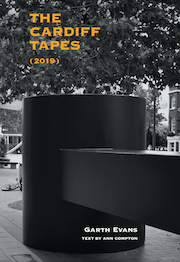In 1972, artist Garth Evans installed a temporary public sculpture in Cardiff, Wales as part of the groundbreaking UK-wide City Sculpture Project. The morning after the installation, he stood beside it and recorded responses from passersby. In 2015, Evans set out on a mission to return the sculpture to the same location in order to make a second recording—how would people respond to it nearly 45 years later? What he discovered upon achieving his goal in 2019 was just how much everything had changed, from cultural understandings about public art to the site, the sculpture, and himself.
The Cardiff Tapes (2019) presents the transcript of Evans’ second recording along with the artist’s reflections on the experiment and a text by art historian Ann Compton on the task of framing it within contemporary public art practice. A follow-up to Soberscove’s The Cardiff Tapes (1972), this book raises questions about artistic success and failure as it explores the stakes in artistic redisplays and the changing nature of public art.

